Friday, August 22, 2008
Here We Go Again
Saturday, August 16, 2008
Wow. Ridiculousness Reaches New High
Bob Jones almost had it right. Allow me to edit. A vote against rail is vote for the freedom, mobility, economic prosperity and a cleaner environment that busses and automobiles bring. A vote for the rail system brings urban jungles, more taxes, more government control, and more pollution.
Thursday, August 14, 2008
Rail Ridership in LA Up Again
But another interesting development is the recent skyrocket in rail ridership and slightly lower bus ridership increases in Los Angeles. The Gold Line in particular is moving up, taking a 39% increase over the same time last year, with all rail up 20%. But the Orange Line and the LA Bus system were up 8% and 6% respectively. Not that 75,000 new riders is anything to to sneeze at on the bus tip, but with only 4 lines, rail ridership increased 53,236 total riders. That is a lot of capacity on four corridors that just got soaked up. Imagine if there were more rail corridors and more possible network connections.
Wednesday, August 13, 2008
An Engineering Professor Should Know Better
First, he parrots the anti-transit talking point of the week about energy efficiency. We covered this earlier but Mr. Setty covers it again. My first thought was some poor sap fell for a line, but then I've been seeing it over and over again. People are actually falling for it, pushing numbers out of context. He also makes the claim that trains aren't that efficient compared to electric cars. Well how about trains that can be improved as well? Lighter, more energy efficient. Technological advances aren't just reserved for cars people.
Second he takes a number about one train and expands it purposefully, hoping his readers won't question him on it. Again I expect better from a professor of transportation.
... each train can carry 300 people, and during the peak times, there is expected to be one train every 3 minutes, for a total of 6,000 people per hour on the peak direction... Managed freeway lanes, such as HOT lanes, are designed to carry 2000 vehicles per hour per lane at free flow speeds, and since they carry express busses and high occupancy vehicles, the average occupancy would be well over 3 people per vehicle, for a total of 6,000 people per hour per lane.This is intellectually dishonest because trains are well...trains. They are three to four of those vehicles coupled together. That blows his numbers all out of wack doesn't it? So instead of 6,000 people, it's more like 24,000 with four car trains.
Finally he states that BRT is more convenient than the rail line and states that people would have to make two transfers. One from their house to the line, then another when they get off the line. I find it hard to believe that if the feeder bus to rail line doesn't go to where their express bus goes now, then their express bus doesn't go to where they want to go now. If the rail line comes every 3 minutes, hits major destinations, and is much faster than crawling traffic I don't really see what the problem is. Especially in a very dense place like Honolulu.
He then talks up how the FTA loves BRT. Of course they like BRT! The Bushies hate spending money on transit. He also points to a BRT study that further muddies the definition of BRT. Who knows what BRT means anymore. All I know is that you can run cars on that lane of concrete, which is what he wants to do anyways with his HOT Lane BRT idea.
This doesn't fly, and I'm really annoyed at the capacity lie. The opposition is getting scared, and starting to grasp at straws. And to top it off, Panos recommended light rail for the subway corridor in Los Angeles.
A less expensive option would be light rail at $100 million a mile - an option Prevedouros supports...James Moore, director of the transportation engineering program at USC, is pushing for a busway because they are cheaper to build. Plus, buses can hold more passengers than rail cars.What?! What is wrong with these engineers? Where is Vukan Vuchic when you need him?
Monday, August 11, 2008
Option of Urbanism: Metro Brings Fundamental Change
Since construction began in the 1970's the Metro system has fundamentally changed how the metropolitan area works... Twenty years ago, there were two regional-serving walkable urban places in the region-Georgetown and Old Town, Alexandria Virginia-both relying on tourism, based upon the historic fabric of these 18th century towns. By the mid-2000s, there were 17 regional serving walkable-urban places in the DC area, and five more are emerging. Of these 17, 16 are built around Metro stations and one without Metro service (Reston Town Center) will get a station by 2012.This is something that is much overlooked by opponents and people that don't get why transit is important. Sure the Metro takes about 800,000 rides a day, but how many trips by car do those 17 centers bypass? The 800,000 rides is a measure of the transit, but what the cost-effectiveness measure and the FTA misses is the ability of these districts to reduce auto-trips. I wish that DC would do a travel survey that showed the difference between mixed use and good transit versus auto dependence like Portland did in 1994. The investment is paying off.
Tuesday, July 29, 2008
Honolulu Noise Machine Might Have Hit a Wall
But we find out that contrary to the noise, a big majority supports the mayor in his handling of the transit situation. It's a pretty safe bet that they are just tired of the noise and are glad someone is taking leadership on the issue.
There are people that say the poll proves the mayor is losing speed such as his opponent. However it seems like they are grasping at straws.As reported yesterday, the Star-Bulletin/KITV poll found that 60 percent of the respondents wanted the city to continue with its rail development plan, while 24 percent wanted it stopped, and the remainder either were not sure or refused to answer.
"I am finding more people from East Honolulu and from the Windward side (two areas that have not strongly supported rail) who are starting to get behind rail," Hannemann said. "They are seeing that this is about the entire island eventually being connected."

Monday, July 28, 2008
Miracle Light Rail Bill Passes
Wednesday, July 23, 2008
Vote for Honolulu Mayor Based on Mode
While I wonder about building an elevated rail line instead of a subway under major arterials, why do people still think that building a huge structure to carry limited capacity vehicles is still a good idea these days. I don't get it!? What am I missing? Why do people think that more operators is a good idea when labor costs are the largest part of the operating budget and you have a ridiculously dense city with a need for a high capacity transit spine? And for good measure make it diesel or some other fuel that puts carbon in the air next to your outdoor cafe. I'm getting cynical.
Sunday, July 20, 2008
Beijing Opens Three Rail Lines in Time for Olympics
The new links, built at a total cost of 22.3 billion yuan ($3.2 billion), increased the number of metro lines in the Chinese capital to eight and the total length of track to 200 kilometers from the current 142 km.
Wednesday, July 9, 2008
Oberstar Talks Process
"What is wrong with us? Are we a third world country?"This is what we have been talking about for the last year and a half. The measurements for cost effectiveness are all messed up and doesn't track the true benefits of rail construction. The federal formulas were created to compare transit to roads, and we know its apples and oranges. I'm glad that Sheriff Oberstar is on our side.
...
But the Dulles rail proponents are hitting a similar wall with rail to Dulles Airport and beyond. Oberstar said negotiations over the project – when it appeared as if the federal government might pull its funding – made it clear that the Bush administration was not supportive of the project.
As with light rail in Minneapolis, the federal administration has not used the appropriate criteria to measure and rate the project. He said they deliberately threw out factors like energy consumption and cost to the commuters when evaluating Dulles rail and other projects.
If those benefits could have been left in the financial analysis of the project, the cost effectiveness of the Dulles rail project – which has been criticized for its "medium low" rating – could be higher, said Oberstar.
Additional factors that should have been part of the Dulles rail project analysis may also have lead the federal government to conclude that tunnel option was cost effective. Currently, the federal, state and local governments are pursuing an "above ground" option because the tunnel option was deemed too expensive and would stall the project significantly.
Sunday, July 6, 2008
Been Thinking About Transit Density Part 2
For San Francisco, Eric and others have looked at what a city wide metro would look like. However I thought it would be good to look at it from the standpoint of the sphere I created for the Oakland Map. These aerials are the same dimensions as the Oakland map as are the 5 mile spheres. In the fine grid of San Francisco, you can see that a metro as envisioned below would create a tic tac toe board where getting from destinations all over the densest parts of the city would be fairly easy.

For San Jose though I took a different approach. Instead of using downtown as the center, like Oakland, I thought about how a metro could be used to reconfigure the city and employment districts of Silicon Valley. What came out of it was a more northern sphere centered around west of the airport where there is a lot of land and buildings that could be rebuilt now that their 20-30 year life might be almost over.
It was hard to not try and cover everything instead of focusing on the sphere. These city sphere metro projects could be pretty inexpensive when compared to their resulting benefit which is why its important to think about the area in much smaller terms and corridors.
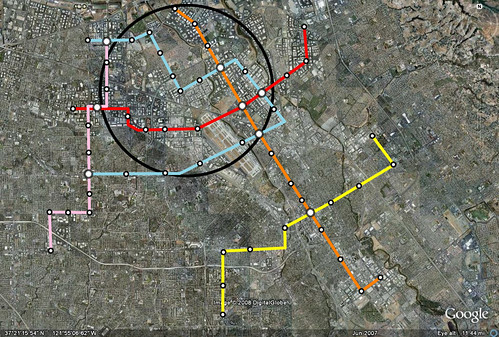
In San Jose in particular, it grew up in such a spread out pattern, that serving the area, unlike Oakland and San Francisco, would be even more daunting. But its possible to use this metro as a starting point to comprehensive feeder bus and commuter rail system that connects the major cities.
Below is an example of this exercise at build out in Austin at the same scale.
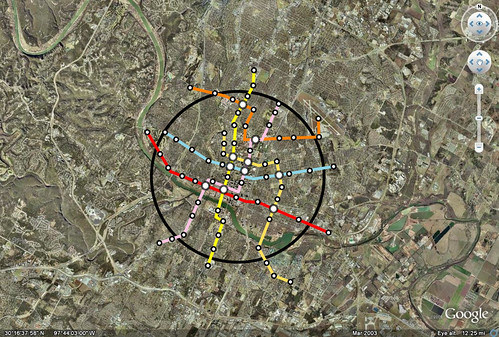
So the point of this exercise isn't to say that these networks should be built with these specific lines, but to show transit density in a core area that would promote the usage of transit in the core while also starting to change the development paradigm. If this type of service were available, walkable neighborhoods would be constructed that have more opportunities to go carless. These networks could also be used as a basis for bike planning.
Saturday, July 5, 2008
Tyson's Corner, Cars
Tysons' dependence on the automobile, and a place to park it, is dramatic when compared with other areas. With about 120,000 jobs, Tysons features nearly half again as many parking spots in structures, underground and in surface lots. That's more parking, 40 million square feet, than office space, 28 million square feet. Tysons boasts more spaces, 167,000, than downtown Washington, 50,000, which has more than twice as many jobs.More spaces than jobs? Who pays for all of those? And doesn't that number tell you something about the benefit of good transit? Yup.
Media as a Minority Opposition Enabler?
What happened to drum up the opposition to have such clout? I'm not sure but the media seemed to be deep in it, and of course would bring readers to the Observer site as well as the John Locke Foundation blog which was the major source for the opposition.
Now in Honolulu we're seeing a massive media blitz, seizing on the conflict to setup and epic battle. Even the opposition leader is running for mayor, just like in Charlotte. Obviously he's not going to win on one issue alone, but it seems rather like a ploy to shine more attention on the division, even if there might not even be a real division by the vast majority on the island.
But the opposition has gotten nasty as well, not being able to win on the issues they are going to nasty depths.
It's gotten so bad in fact that the local paper has asked everyone to tone it down, something which they were enablers of and allowed to get out of hand even in their own paper. I have never seen an article on the facts or benefits, just who said what.In the most recent attack circulated via e-mail last weekend, a satirical illustration and text compared rail advocates to al-Qaida leader Osama bin Laden and the Nazis. Hannemann administration officials said the e-mail "crosses the line."
The e-mail, with the subject line "People in Hawaii Are Too Stupid -- DON'T Let Them Vote on Rail," features a photo of Osama bin Laden with the message, "People of Oahu, you should NOT be allowed to make any big decisions in the ballot box. Only Mufi and his friends should decide."
I think though that the Mayor has done the right thing by fighting back. There is no reason he needs to take a beating like this, especially from folks funded on the mainland by highly ideological anti-rail groups.
It will be interesting to see how this plays out. This is the reason though that there has to be a strong leader at the front of these things. If not, it will die under the onslaught of a well funded opposition. The one common theme in all cities that have started with rail or have been able to continue is a strong mayor or governor pushing it hard. If you want transit, a leader like the mayor is key.
Wednesday, July 2, 2008
Been Thinking About Transit Density Part 1
Some thoughts before I read it though based on what I've read in Richard's posts and my own evolution in thinking.
I had a bit of a thought today that should have come together sooner but I was looking over Google Earth at a way to connect commuter rail/HSR directly to downtown San Jose instead of the current just outside of downtown location of Diridon station. It seems to me that what is needed in each city around the bay is a local metro that moves people quickly around the central city. Each of these metros can be connected by commuter rail lines like Caltrain along commuter corridors but the most beneficial systems will be those that serve future density, not just existing transit.
I started writing this post before going to Washington with the hope that on the plane I could make some maps. The good part is that the trip reaffirmed what I wanted to back up. That an in town metro is important to vibrancy and movement in a city. Serving the suburbs should be done, but the way we are going to make our transit systems work is with good circulation in the center to build up core density. If we could see where Washington DC was before Metro and where it is now, you would see a huge difference in the city. If the current naysayers were around then to kill projects, that project would have never been built, and the city would look very different.
But other cities should look to the future in the same way. The future benefits outweigh current costs and with more people preferring to live a city life, its got an increased benefit of soaking up growth that would usually cause gross distortions in where people live and work. This is the option of urbanism like Chris Leinberger says.
So we'll start at Oakland. Previously I made a fantasy map for an Oakland Metro that you see directly below.
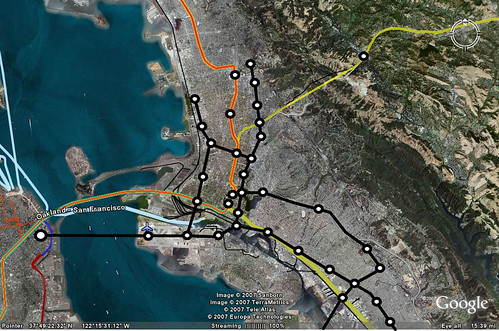
This was based on getting people in and out of a city, and not really a core urban strategy. I realize that now, but when you compare it some of the Subway systems that work really well it doesn't really look quite right.
Vienna's Metro looks different. There are a number of lines that criss cross a number of ways. The same with the Washington Metro.
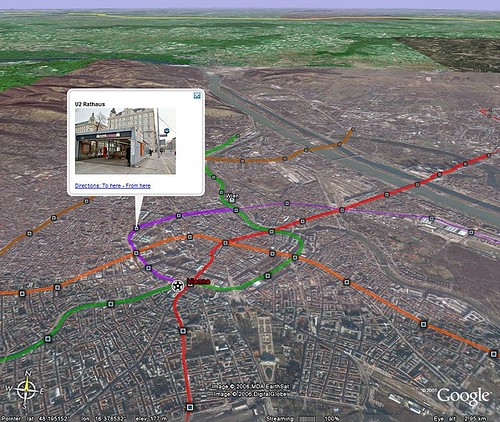
 With that being said, here's a more core system. I've come up with these for San Francisco, Oakland and San Jose as the major regional centers but am thinking about doing other cities as well. The Space Race focuses so much on suburban serving transit that the core again is left out. But perhaps this is the way we should rethink it. We'll start with Oakland.
With that being said, here's a more core system. I've come up with these for San Francisco, Oakland and San Jose as the major regional centers but am thinking about doing other cities as well. The Space Race focuses so much on suburban serving transit that the core again is left out. But perhaps this is the way we should rethink it. We'll start with Oakland.
Now all of these maps will be at the same scale for the Bay Area. The circles are about 5 miles across and show a primary core that could densify in corridors and the core soaking up a lot of housing need and with less energy usage from density, walkable neighborhoods, and easier access to close districts.
Now I'm not sure that this necessarily needs to be a Metro Subway. It could be a dedicated lane streetcar or light rail. However a subway can go from end to end without having to stop at a light and stay on schedule with faster speeds. This facilitates use. But it might work in a smaller city with a smaller sphere than the five miles for core circulation. We should think about these implications and ask, what will get us the most riders and most future benefit instead of just thinking about cost and as I've mentioned before just bringing people into the center of the city.
Monday, June 30, 2008
Sloooow Subway Escalators
Slooowww Dupont Circle
Faaast Budapest
Thursday, June 26, 2008
Hawaii Mayor Calls Out the Opposition
Mayor Mufi Hannemann criticized the media for doing a poor job of challenging opponents attempting to stop the city's planned $4 billion rail-transit project, prompting him to spend campaign funds to take out advertisements.These guys are big rabble rousers that spread a lot of misinformation. It's funny that these guys only fight in regions that don't have rail yet because they can't beat back the facts on the ground. But everywhere they fight they fail and move on to the next city without. This however is the funniest comment of the bunch:In his first interview since ads ran in Honolulu's two daily newspapers last weekend, Hannemann said yesterday he stands by his assertions that the local anti-rail campaign is backed by mainland companies and individuals connected with the oil and automobile industries.
All three local rail critics denied Hannemann's assertions, calling them "ridiculous," saying they have not accepted any money from mainland companies. "We have not received a penny that we did not raise locally," said Slater, a vocal critic of the 20-mile rail system from Kapolei to Ala Moana.Cliff Slater is associated with the Reason Foundation as an Adjunct Scholar. The Reason Foundation has gotten at least $321,000 from Exxon. Their funders also include the following; Chevron, Exxon, Continental Airlines, Delta Airlines, Daimler Chrysler, Ford, General Motors, National Air Transportation Association, Western States Petroleum etc etc. Hmmm...
Sunday, June 22, 2008
Arlington Did It Right
It got me thinking, what would BART look like if they had made the decision to build like Metro in DC and run the line through main corridors instead of down the center of the freeway. Here is what I came up with. The dotted lines and black dots I drew and the regular line and existing stations are shown by the little BART symbols.
If I were to speculate that these stations would have the ridership of 24th and 16th street mission, we would be seeing an additional 110,000 riders.
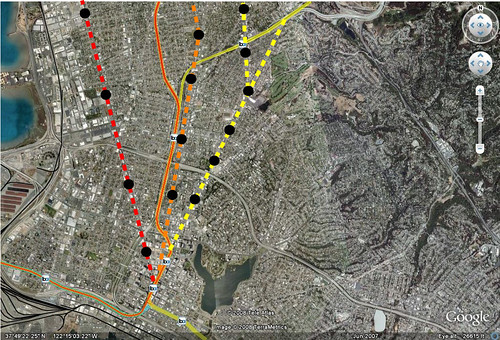
Since BART didn't learn anything from Arlington either, the BART to San Jose line will make the same mistakes, running on existing ROW instead of down the main corridors where its needed. The same exists with the BART to Livermore extension which we discussed earlier.
Friday, May 16, 2008
Transfer of Wealth
If oil -- using the price for sweet light crude -- stays to $125 a barrel for the rest of the year, the average price of oil over the course of 2008 will be around $115 a barrel. The average 2007 price was around $70 a barrel. The $45 a barrel y/y increase in the average price of oil is equivalent to going from $25 a barrel oil to $70 a barrel oil in a single year. It is a large jump. It would lead to something like a $650-700 billion transfer of wealth from the oil-importing economies to the major oil-exporting economies.It's very very disgusting. Actually, you know I saw an article on Wired's blog about Dubai's awesome Metro today. The sad thing is that it was basically funded by us.
The system will carry 200 million passengers a year, about 547,000 passengers each day. Officials hope to have almost 200 miles of subway lines built by 2020, at which point it would be one of the largest automated subway systems in the world.That could have been LA.
Wednesday, May 7, 2008
Miami Faces Some Hurdles, Is the Next Dulles
This is another Dulles. I fully expect to see Peters and Simpson to whip out a big red pen on this project. The Feds don't believe in Metros and will not as long as they are compared to highways using highway metrics. They've made it abundantly clear that all they care about is tolls and roads. Don't believe the lip service.Desperate to regain a shot at $700 million in federal funding for expanded Metrorail service, Miami-Dade leaders promised Monday to quickly improve the county transit department's financial and operational plans.
''We're going to have to have not only great planning, but great action,'' said U.S. Rep. Kendrick Meek, D-Miami, who prodded the Federal Transit Administration to write a step-by-step plan last month for reviving the county's funding application.
Tuesday, April 15, 2008
Steal an Opportunity for Our Children's Future, Fund Metro!
But the Davis bill, as it is currently constructed, will likely never make its way past Coburn. “I’m happy to be a roadblock to that bill,” Coburn tells WTOP. “It’s $1.5 billion they want, we (the government) don’t have the money to pay for it, so where are we going to get the money?”Coburn doesn’t think one penny of funding for Metro should come from American taxpayers. “How dare us say we are going to steal opportunity from our children so that we can have a ride on the Metro. I think the vast majority of Americans would disagree with that.Wha?! Is this guy serious? No Tom, they disagree with YOU. Even Republicans disagree with you which is why Tom Davis (R) is trying to get the funding through. I feel bad for progressives in Oklahoma, first the Global Warming denier Inhofe and now Transit denier Coburn. What is it with politicians from non-transit non-urban regions telling dense regions benefiting from transit what to do in terms of transportation policy? Get rid of these bums already. Like its not bad enough that $1.5 B is chump change in an Iraq day.
H/T Second Avenue Sagas
